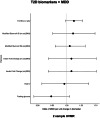Evidence of bidirectional relationship between type 2 diabetes and depression; a Mendelian randomization study
- PMID: 40595333
- PMCID: PMC12532585
- DOI: 10.1038/s41380-025-03083-0
Evidence of bidirectional relationship between type 2 diabetes and depression; a Mendelian randomization study
Abstract
Major depressive disorder (MDD) and type 2 diabetes (T2D) represent two global health challenges with a high degree of co-occurrence. Here, we aim to investigate the causal relationship between MDD and T2D in diverse ancestries using Mendelian randomization (MR) in GWAS summary statistic and individual level (UK Biobank (UKB)) data. We assessed the bi-directional causal relationship between: (a) MDD and T2D and (b) MDD and glycaemic biomarkers (e.g. TG:HDL-C ratio, a measure of insulin resistance, fasting glucose) in non-diabetic individuals. In UKB we also tested the role of T2D on treatment resistant depression (TRD). We used multivariable MR (MVMR) to assess the role of body mass index (BMI) in the MDD to T2D relationship. Our results demonstrated that a doubling in MDD genetic liability was associated with 1.14 higher odds of T2D (95% CI:1.09, 1.19), whilst a doubling in T2D genetic liability associated with 1.02 higher odds of MDD (95% CI:1.01, 1.03). Consistent effect estimates were observed in the UKB when stratifying by sex and suggested a role for T2D in TRD. T2D GWAS derived clusters of genetic variants highlighted the importance of specific pathways in the MDD relationship, including variants raising T2D risk via body fat (OR:1.04; 95% CI:1.02, 1.06), obesity mediated insulin resistance (OR:1.06; 95% CI:1.04, 1.09) and residual glycaemic (OR: 1.02; 95% CI:1.00, 1.04) pathways. MVMR with BMI attenuated the bidirectional relationship between MDD and T2D, particularly from MDD to T2D. Genetic liability to MDD was also associated with higher TG:HDL-C ratio in individuals without T2D (β:0.11; 95% CI:0.08, 0.14). We provide evidence of bidirectional causal association between MDD and T2D, with MDD strongly predicting insulin resistance and T2D. T2D predicted both MDD and TRD and highlighted the importance of obesity and body fat pathways in the T2D to MDD relationship.
© 2025. The Author(s).
Conflict of interest statement
Competing interests: The authors declare no competing interests. Ethics approval and consent to participate: All methods were performed in accordance with the relevant guidelines and regulations (AJ-checklist). UK Biobank received ethical approval from the North-West Multi-Centre Research Ethics Committee (REC reference: 11/NW/03820). All participants gave written informed consent in accordance with the principles of the Declaration of Helsinki. We applied to UKB and have access to UK Biobank resource under application number 103356. This study does not include any identifiable images from human research participants.
Figures




References
-
- Zheng Y, Ley SH, Hu FB. Global aetiology and epidemiology of type 2 diabetes mellitus and its complications. Nat Rev Endocrinol. 2018;14:88–98. - PubMed
MeSH terms
Substances
Grants and funding
LinkOut - more resources
Full Text Sources
Medical
Miscellaneous

